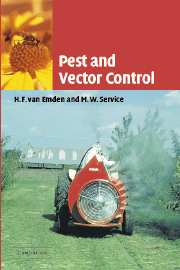Book contents
- Frontmatter
- Contents
- Preface
- 1 Man and insects
- 2 The causes of pest and vectored disease outbreaks
- 3 Insecticides and their formulation
- 4 Application of insecticides
- 5 Problems with insecticides
- 6 Environmental/cultural control
- 7 Biological control
- 8 Insect pathogens
- 9 Genetic control
- 10 Pheromones
- 11 Plant and host resistance
- 12 Other control measures and related topics
- 13 Pest and vector management
- Appendix of names of some chemicals and microbials used as pesticides
- References
- Index
7 - Biological control
Published online by Cambridge University Press: 03 December 2009
- Frontmatter
- Contents
- Preface
- 1 Man and insects
- 2 The causes of pest and vectored disease outbreaks
- 3 Insecticides and their formulation
- 4 Application of insecticides
- 5 Problems with insecticides
- 6 Environmental/cultural control
- 7 Biological control
- 8 Insect pathogens
- 9 Genetic control
- 10 Pheromones
- 11 Plant and host resistance
- 12 Other control measures and related topics
- 13 Pest and vector management
- Appendix of names of some chemicals and microbials used as pesticides
- References
- Index
Summary
Introduction
One of the oldest methods of pest control is the use of other animals as carnivores to reduce pest numbers. More recently other biological organisms, such as microbes causing insect diseases, plants which are resistant to pest attack and animals that tolerate, at least to a certain extent, infection with diseases, have been used for pest and disease control. These are discussed in succeeding chapters, while ‘biological control’ in this chapter is limited to the use of animals that are natural enemies of insects. There are no elementary recent texts on biological control; the slim volume by Samways (1981) can still be recommended. An excellent recent book, but an advanced text (more than 500 pages), is that by Van Driesche and Bellows (1996).
History of biological control
The use of biological control is probably about as old as the history of agriculture. Chinese cave paintings clearly show ducks being used to consume pests at the base of plants in rice paddies, a technique still in use in China today. However, the first well documented case of biological control occurred in 1762, when a Mynah bird (Gracula religiosa) was brought from India to Mauritius to consume locusts. In the 1770s, the practice developed in Myanmar (Burma) of creating bamboo runways between citrus trees to enable ants to move between the trees more freely for the control of caterpillars.
- Type
- Chapter
- Information
- Pest and Vector Control , pp. 147 - 176Publisher: Cambridge University PressPrint publication year: 2004
- 1
- Cited by



